

NPR Training. The ear training guide for audio producers (Suharu Ogawa for NPR) Ear training, the practice of learning how to recognize certain sounds, is a must for audio producers.
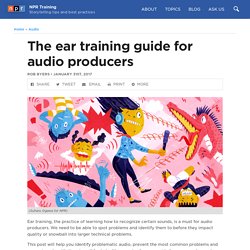
We need to be able to spot problems and identify them to before they impact quality or snowball into larger technical problems. This post will help you identify problematic audio, prevent the most common problems and recognize when it’s time to call for help. It’s a great reference guide for anyone who works with audio, from new producers to seasoned veterans. Asking the expertsNPR Training’s Rob Byers and two NPR audio engineers took audio production questions during a reddit AMA.Want to learn more?
Preventing audio problems is one of the keys to ensuring quality productions. If you do anything with this guide, learn how to recognize and prevent each problem. The guide has three main sections: Recording problems These issues occur while recording in a studio or gathering audio in the field. Resource Toolkit for Instructional Designers – Support Site for EDCI 569 Introduction to e-Learning. A Juicy Collection of Bloom's Digital Taxonomies! Today, educators are overwhelmed (literally drowning!)
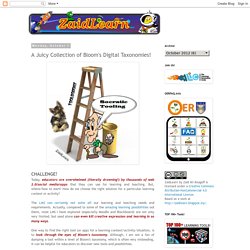
By thousands of web 2.0/social media/apps that they can use for learning and teaching. But, where/how to start? How do we choose the right solution for a particular learning context or activity? The LMS can certainly not solve all our learning and teaching needs and requirements. Actually, compared to some of the amazing learning possibilities out there, most LMS I have explored (especially Moodle and Blackboard) are not only very limited, but used alone can even kill creative expression and learning in so many ways. One way to find the right tool (or app) for a learning context/activity/situation, is to look through the eyes of Bloom's taxonomy. But, please keep in mind that many tools/apps can easily be used for all the levels of Bloom's taxonomy with an open and creative mindset. Here is a collection of Bloom's digital taxonomies that I have discovered until now: Updated version (2014): Old Version: Source Source Source. SimSchool: A Simulation about Educational Philosophy by Lloyd Rieber.
What is really true? Lloyd Rieber's home page 1998 Peter Dean Lecture Lloyd Rieber The University of Georgia When discussing philosophical orientations and their implications to learning and education, I like to use this little exercise.
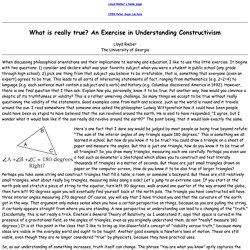
It begins with two questions: 1) consider and declare what was your favorite subject when you were a student in public school (any grade through high school); 2) pick one thing from that subject you believe to be irrefutable, that is, something that everyone (even an expert) agrees to be true. This leads to all sorts of interesting statements of fact, ranging from mathematics (e.g. 2+2=4) to language (e.g. each sentence must contain a subject and a verb) and history (e.g. Here's one fact that I dare say would be judged by most people as being true beyond refute: "The sum of the interior angles of any triangle equals 180 degrees. " So, as our understanding of something increases, truth itself can change. Learning with 'e's. Apa-format-1. Instructional Design at lynda.com: How We Do What We Do. By Jolie Miller | Wednesday, May 13, 2015 One of the most common questions we get here at lynda.com is: How do you do what you do?
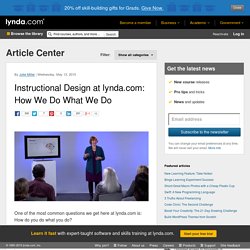
While there’s a certain amount of magic that happens on our campus (it’s impressive, I’ll be honest), a lot of our process boils down to simple instructional design principles for teaching adult learners. Whether you’re teaching a friend how to knit, creating online instruction, or just want to be able to better communicate—these strategies don’t disappoint. Here are my 10 favorite tips: 1. Great teachers take the complex and re-explain it simply, sharing in the excitement of someone new to the topic. To brush up on your communication skills, check out Communication Fundamentals, Communication Tips, and Effective Listening. 2. You can’t teach anyone anything until you know who you’re teaching, where they’re at today, what they want to learn, and why they want to know it. 3. 4.
When I’m learning, I’m vulnerable. 5. 6. 7. 8.
How to Build Your E-Learning Portfolio – Part 2. This post is one in a four-part series for How to Build Your E-learning Portfolio.

You can read Part 1 here. Common Challenges I understand that building your portfolio can be challenging. As are most things in life. Maybe you aren’t legally allowed to share your work samples because they’re controlled goods or you’ve signed an air-tight Non-Disclosure Agreement;Maybe you don’t have time…we’re not all Beyonce; orMaybe you don’t know where to begin.
My goal here is to become your portfolio-building sensei and hold your hand through this entire process. Challenging Yourself Now, you may already feel challenged by those challenges impacting your lack of portfolio, but I’m asking you to challenge yourself even more! Before taking the leap into full-time independent contractor-ship, I knew that I needed some sort of portfolio. At first I wallowed, but then I had some real-talk with myself, got serious, and created my first two portfolio pieces. Go Design Something. The Illustrated Professor. I am just finishing up teaching an eight-week, one-hour course I developed for our Freshman Seminar Program here at Angelo State.
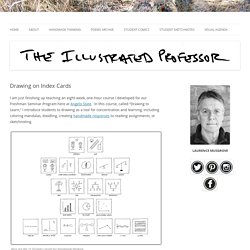
In this course, called “Drawing to Learn,” I introduce students to drawing as a tool for concentration and learning, including coloring mandalas, doodling, creating handmade responses to reading assignments, or sketchnoting. Here are the 21 formats I teach for handmade thinking My students and I have been using drawing as a learning tool in all of my classes for some time now, but this is the first course where I’ve focused the entire class on the topic of drawing to learn. The main ideas for this course are rooted in the work of Ed Emberley, Dan Roam, Sunni Brown, Dave Gray, Scott McCloud, Lynda Barry, Austin Kleon, and Mike Rohde.